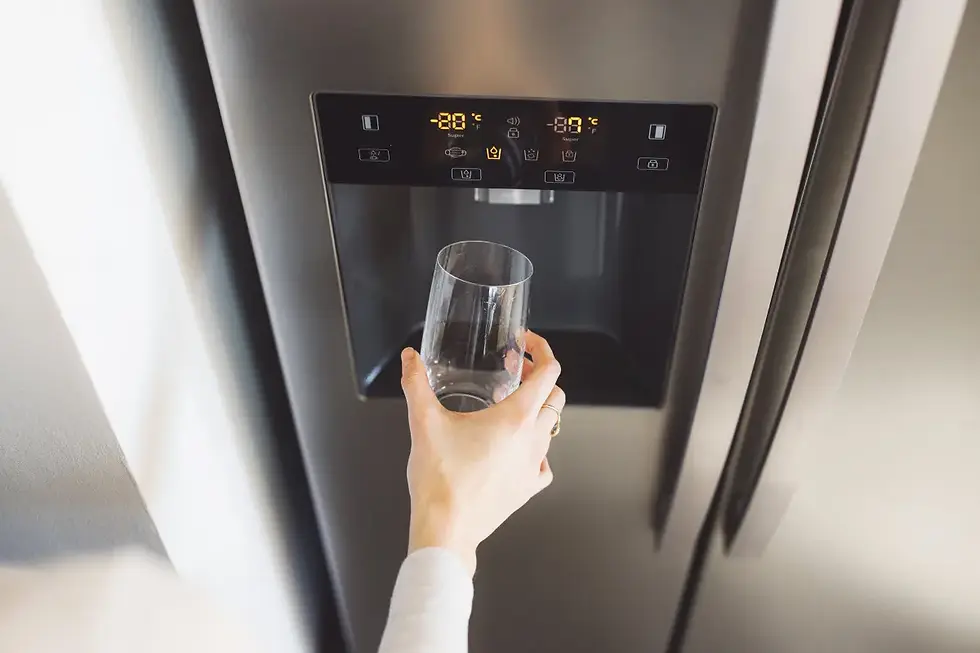How to Change a Fridge Water Filter | Step-by-Step Guide
- MasterFix

- Aug 1
- 4 min read
Updated: Aug 17

How to Change a Fridge Water Filter: Step-by-Step Guide for Fresh, Clean Water
Is your refrigerator water tasting strange or dispensing slowly? It may be time to replace your fridge water filter. A properly functioning water filter is essential for removing bacteria, rust, and sediment from your drinking water—ensuring both great taste and health.
In this guide, we’ll show you how to find and replace your fridge’s water filter, understand different filter types, know when it’s time to change it, and provide maintenance tips. We’ll also let you know when it’s time to call MasterFix Appliance Repair Service for professional help.
Why Is Changing Your Fridge Water Filter Important?
Your refrigerator’s water filter helps remove harmful particles like chlorine, rust, and dirt, ensuring clean and fresh-tasting water and ice. Over time, the filter becomes saturated and less effective, which can lead to:
Foul-tasting or smelly water
Slow or weak water flow
Cloudy or speckled ice
Increased strain on your fridge’s water system
Replacing the filter regularly keeps water quality high and helps maintain your appliance’s performance.
When Should You Change Your Refrigerator Water Filter?
Most manufacturers recommend replacing the water filter every six months, but you may need to do it sooner if you notice:
Bad-tasting or smelly water
Black specks or cloudiness in water or ice
The water filter indicator light turns on
More than a year has passed since the last replacement
Reduced or stopped water flow from the dispenser
Always follow your fridge’s built-in indicator or manual guidelines for optimal timing.
Where Is the Refrigerator Water Filter Located?
Common filter locations include:
Inside the fridge, in the upper right corner or side wall
Behind the grille at the base
At the back of the refrigerator
Underneath or behind the fridge (for inline filters)
Check your owner’s manual or the manufacturer’s website to find the exact filter location for your model.
How to Change Different Types of Refrigerator Water Filters
1. Twist-on Water Filter Replacement
Locate the filter (inside the fridge or behind the base grille)
Turn the old filter counterclockwise to remove
Remove protective caps from the new filter
Insert and turn clockwise to lock it in
Run water for 3–4 minutes to flush air and debris
Reset the indicator light if needed
2. Push-in Water Filter Replacement
Locate the push-in filter inside the fridge
Press the release button or tab to unlock
Pull the old filter straight out
Attach the cap from the old filter to the new one if required
Push the new filter in firmly until it clicks
Flush water through the dispenser
Reset the indicator light
3. Inline Water Filter Replacement (typically behind or beneath the fridge)
Turn off the refrigerator’s water supply
Use pliers or a wrench to disconnect the water line
Replace the old filter and securely reconnect the lines
Turn the water back on and check for leaks
Flush the system through the dispenser for several minutes
⚠️ Inline filters may require tools and are best handled by professionals.
4. Bottom or Rear Filter Replacement
Remove any access panels or grilles if necessary
Turn the old filter counterclockwise to remove
Insert the new filter and turn clockwise to secure
Reattach any covers or grilles
Run water to flush out carbon residue
Tips to Maintain Your Refrigerator Water Filter
Replace your filter every 6 months or as recommended
Keep your fridge and freezer clean to prevent contamination
Monitor the filter indicator light—yellow or red means it’s time
Use only filters compatible with your fridge model
Always flush new filters before use to remove carbon dust
What About the Refrigerator Air Filter?
Many modern refrigerators also include an air filter to neutralize odors and reduce bacteria.
Location: Usually behind a vent in the fridge compartment
When to Replace: Every 6 months, or if odors persist or food spoils quickly
How to Replace: Remove the old filter, install the new one facing the correct direction, and reset the filter indicator
When to Call MasterFix for Refrigerator Water Filter Service
If you're experiencing any of the following, it's time to call in a professional:
Difficulty locating or replacing the filter
Persistent water quality issues
Water dispenser malfunctions or leaks
Inline filter installation or removal
At MasterFix Appliance Repair Service, our certified technicians offer:
✅ Professional water and air filter replacement✅ Water line and dispenser diagnostics✅ Same-day service with upfront pricing✅ Repairs backed by warranty for peace of mind
Keep Your Water Clean with Regular Filter Changes
Clean, great-tasting water starts with a fresh filter. By staying on top of your filter replacement schedule and performing regular maintenance, you’ll keep your water safe and your appliance running efficiently.
Need help? Call MasterFix Appliance Repair Service today for fast, expert service.
Frequently Asked Questions About Refrigerator Water Filters
1. Do I need to turn off the water before replacing the filter?It’s recommended, especially for inline and rear-mounted filters. For internal twist or push filters, it’s not always necessary—but it’s safer.
2. How much water should I run after installing a new filter?Flush 1–2 quarts (4–8 cups) of water through the dispenser to clear out carbon particles and ensure clean water flow.
3. How often should I replace the water filter?Every 6 months is the general rule. Replace sooner if you notice poor water taste, slow flow, or cloudy ice.
4. Can I replace the water filter myself?Yes—most twist-on and push-in filters are easy to replace using your manual. Inline filters, however, may require professional help.
5. What happens if I don’t change the filter?An old filter can clog, reduce water quality, strain your refrigerator’s system, and even cause leaks or breakdowns over time.
Let MasterFix Appliance Repair Service help you keep your refrigerator running like new. Contact us for professional, reliable filter replacement and appliance care!




Comments